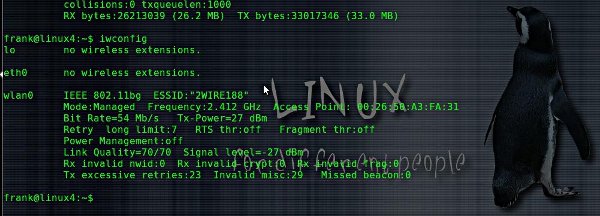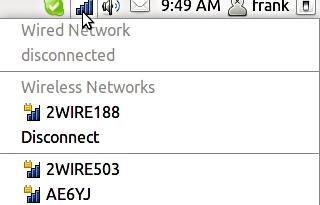Article by Frank Harris-Smith
Linux is fundamentally a command line Operating System. Anything and everything can be done through the command line – system configuration, connecting to WiFi access points, even accessing new hardware devices before the Linux Kernel gets a driver for it (like USB Flash Drives before Linux Kernel 2.4 – pre 2001)
A quick example is the iwconfig command. Here is a quick peek at my current WiFi connection as seen from the command line:

By typing “man iwconfig” into your terminal you’ll get a detailed listing of the command’s parameters. You can configure your WiFi connection from A to Z with iwconfig.
You don’t actually need a GUI (Graphic User Interface) to do everything that needs done in Linux. You can run just about any old system on Linux using a pure command line interface. Like setting up any old doorstop of a computer as a Linux-Powered Apache Web server.
However…
What is a computer? Long ago when home computers were just just beginning, back in the mid 1970s, there was a magazine called Byte. In one issue was a definition of what a computer is – “A mind-amplifier” Three simple words that say a lot.
The output quality is directly proportional to the input quality of any amplifier. Just go to a Karaoke bar. There will be “singers” where you actually pray for an electrical failure.
The Linux command line makes an excellent foundation for a GUI interface. Why type endless commands into a terminal when you can do the same thing with one or two clicks of a mouse? Like this:

My point is this. Time spent making the Operating System do things digs into your time being creative. A GUI should be like well broken in tennis shoes. Something that “Just Does It” for you and doesn’t distract you from the task at hand.
In the Linux Universe are a large number of GUIs to choose from. Linux GUIs, called “Desktop Environments” or Desktop Managers, come in a variety of different types.
For low power PCs
There are the low-resource Desktop Managers . For small memory/slow processor systems. Not a lot of flashy eye-candy but they get the job done.
My first Linux laptop was a Dell Inspiron 3200, a Pentium II processor with a maxed out 144 Megabytes of ram.
The Linux solution for such an an antique of a laptop was Xubuntu – Ubuntu 6.04 with the XFCE (XForms Common Environment), which is lightweight but as easy to use as Windows 98. Here is the link to the Xubuntu website http://www.xubuntu.org.
No crashes. No malware worries. No evil “blue screens of death”
Getting Linux to actually work on a laptop in 2006 permanently
changed my expectations and perspective on “Mind Amplifiers”
XFCE is a pretty elegant solution to the low resource PC, like what I had with my Dell Pentium II Laptop. There are many more low resource Linux distros, just Google “low resource Linux distros”
To give you some names: Lubuntu, Puppy, Bodhi Linux, Crunchbang, Archbang
For modern PCs and Laptops
For those who prefer the Windows style interface there’s the KDE (for K Desktop Environment), a more Windows-like but most important, Uniform in appearance and function. I personally don’t prefer KDE but you might. You can take a look at http://www.kubuntu.org/.
The Ubuntu release with this Desktop Environment
Most KDE applications can run under other other Desktop Managers such as Gnome. As an example, The Kstars Desktop Planetarium, which will answer that question “What’s that bright object I saw near the horizon just before sunrise?”.
GNOME (GNU Network Object Model Environment) is my second favorite Desktop Manager. It runs very well on my IBM ThinkPad T-42 laptop with it’s 1.7 Gigahertz Pentium “M” processor. An earlier laptop, an IBM ThinkPad 600X gave me acceptable speed (better than Windows 2000) and stable performance.
The Gnome interface is somewhat Macintosh-like in the way it does things. Drives mount and unmount right on the Desktop just like the Macintosh and menu placement is similar to the Mac. See http://www.linuxmint.com/screenshots.php for screenshots
For High Power Systems
How about something for my gaming system, a Dual Core AMD powered system with 2 gigabytes of RAM and an nVidea gaming graphics card?
My new favorite Desktop Manager it’s the new default of Ubuntu : http://www.ubuntu.com/
Just this year Ubuntu came out with a new Desktop Environment called Unity. Actually Unity is not a Desktop Manager. It’s a Shell that runs on top of Gnome.
Unity is currently my new favorite Desktop Manager. It’s fast, looks good without being annoyingly flashy, and still has Ubuntu Linux “Under the Hood”
This was meant only to be a quick introduction to the many Desktop Managers available for Linux. There are many other great looking and performing Desktop Managers for Linux “Out There” – just Google “Linux desktop managers”
The hardest part of choosing a Desktop Manager
will be wading through the choices.
Popular Posts:
- None Found

Good article but one small but important correction should be made… Linux is not an operating system, It is a kernel. The operating system that he talks about is GNU/Linux. GNU is the bigger part.
Thanks Martin.
Sometimes i forget to correct that, i know this and for me is natural but you have reason, in articles like that it’s always important repeat the basic concepts.